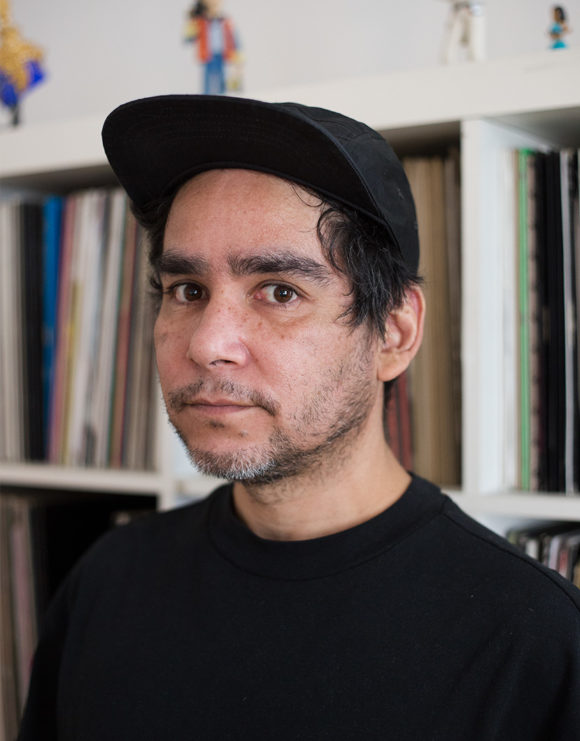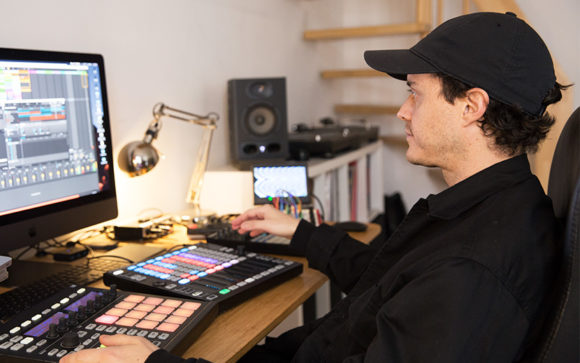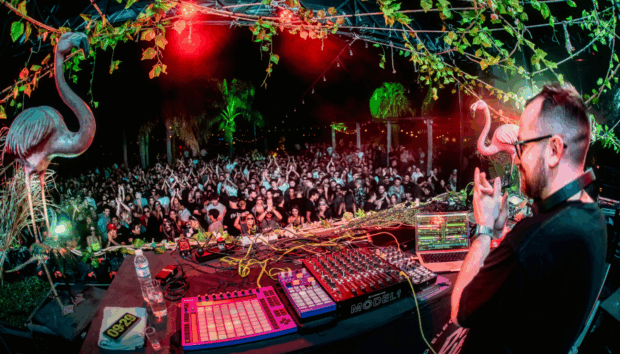In one corner of Felipe Salmon’s Neukölln studio sits a bundle of animal hooves fastened to strips of multi-colored twine. They’re the size and color of mushrooms: beige and inky black, polished smooth around their hooked peripheries by years of use. “I also have a lot of different seeds tied together,” Salmon says offhandedly. They lie beside pig nails, goat nails, and the elongated nape of a mummified donkey jaw. The specimens are traditional chajchas rattles from the Peruvian Andes, close to Lima, where Salmon and his production partner, Rafael Pereira, are originally from. Since 2010, their musical output as the Afro-electronic duo Dengue Dengue Dengue has put tools like these at its heart, bringing sounds once relegated to the coffers of old-school cumbia, chicha, and musica criolla into the glitched-out club music of the 21st century. Their newest EP, Fiebre, is the culmination of their last decade of experimentation, built by layering acoustic percussion in trippy minimal polyrhythms with the help of contemporary plug-ins and synths.
“This is a style we’re going to be exploring for a while now,” Salmon says. “We’re trying to make new sounds rather than imitate someone else.” The new genre he’s referring to is dark and off-kilter. Across seven tracks, he and Pereira layer cut-ups of Peruvian drums, recorded live during trips back to South America or with the instruments they have at their disposal in Berlin, with loopy synth lines that hew loosely to overlapping time signatures and grids. The spirit lies somewhere between Peruvian instrumentation and the rhythmic sensibility of gqom and ‘90s IDM; a song might syncopate a cantering cajón – a Peruvian box drum played by slapping its sides – with fitful footwork-influenced squelches, or place lolling congas over a beautiful waft of ambient synths. True to NAAFI, the Mexican conceptual club label that released the EP on October 16, the tracks mine darker depths than some of the duo’s past LPs, eschewing lively dance floor anthems for repeating minor-chord arpeggios, or no melodies at all.

It’s been important for Salmon and Pereira to explore the world beyond easy-to-digest four-to-the-floor. “It’s not that 4/4 is boring – it’s the rhythm of your heart. It puts you in a meditative trance. It’s amazing. But there’s also a whole other universe there if you forget about the grid,” Pereira says. “If you work with the space and slice it into other things, then you have more space for more stuff.” The pair have learned to look at their productions like pieces of a puzzle that can be broken apart and reassembled in their DAW. One project may start at 120 BPM in 4/4. Once the first beat is laid down, a second beat will be layered on top of it at 140 BPM in 3/4. “You have to look at the spaces between the beats,” Salmon describes. “If you compress a faster 3/4 track into the original 4/4 BPM, somehow it works.” The lilting effect that this technique produces has become one of Dengue Dengue Dengue’s trademarks, appearing in songs like “Del Alma” from their self-released compilation, Kebrada; and “Atlantida,” “Hyperborea,” and “Lemuria” from their album Continentes Perdidos.
While these rhythmic concepts seem complex, Pereira and Salmon’s philosophy is simple: to get the message across in the fewest number of elements possible. Most of their actual recording processes are done ad-lib, with little prepared in the way of a concept. Even the dizzying polyrhythms that result are typically the outcome of chance experimentation rather than set formula. One of the most rhythmically intricate tracks on Fiebre, “Yaama,” only contained five stems when it was finished. It started from recording sessions made months in advance of the overarching concept that would come to define each of the album’s tracks. “I had Peruvian percussionists record stuff at 100 BPM, 130 BPM, and so on,” Salmon says. “So then I just had a lot of samples and rhythms that I could work with afterwards.” When it came to “Yaama,” he started out with a bassline inspired by old-school dubstep. Then he cut up and adapted the percussion samples that he brought back with him from Peru. “None of it was just the straight percussion we recorded,” he explains. He cut up and modified the samples into loops that he layered over the basslines and synths until he was happy with how it sounded.
Some of the drums the duo make to supplement their acoustic recordings they craft from Native Instruments’ POLYPLEX, as well as a suite of other plugins. They almost always process their audio with the RAUM reverb, which they use as a send track in their DAW, and the REPLIKA delay. (“You can’t just play percussion without effects over electronic music,” according to Salmon.) They then layer each sample with different reverbs to create a sense of three-dimensional space. They might start from one element, like a synth lead crafted from the Waldorf Streichfett, and add sounds and effects to it little by little. They then boost the beats with compression, saturation, and overdrive to give the songs a stronger sound, and sidechain select frequencies to avoid a muddled lower end. When they have the track arranged, they’re ready to export loops and samples to a more versatile live setting, where they’re often joined by live percussionists.
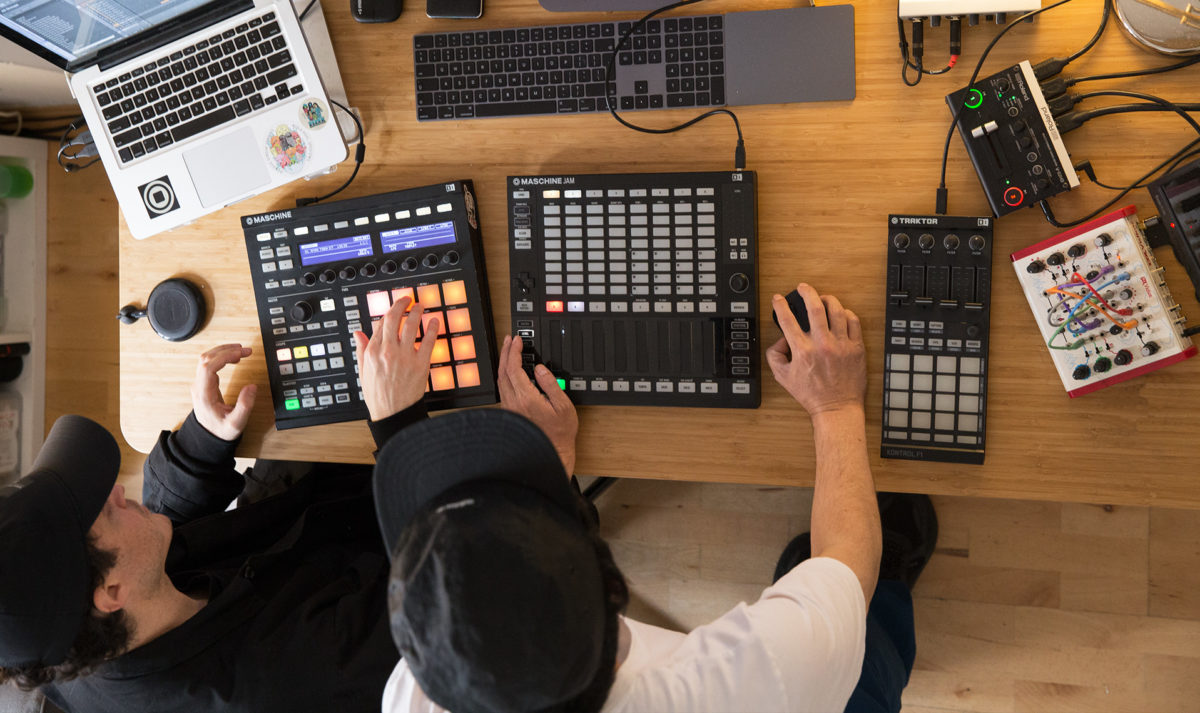
“When we play the live versions of these tracks, we always use the Maschine,” Salmon says. He cues cut-up samples and pre-recorded loops from the DAW. When they’re playing with Peruvian drummers, they keep to a fairly set arrangement that deviates very little from the already-finished track. A change too major could mean confusing the live musicians and losing the thread of the song completely. When the duo is playing by themselves, however, they can use MASCHINE to replicate more organic live percussive sounds without the band. “I can trigger the percussion directly and play them with a more human touch,” Salmon says. “I can also add texture to them or take out sounds from the original track.” It’s a setup that the duo has been using for years, even bringing it with them to Peru to record with the cumbia band Los Wembler’s de Iquitos in 2017. Integrating MASCHINE has allowed for much richer collaborations, he adds, because it’s easy for more traditional instrumentalists to adapt to.
These musical partnerships are just the first step in bridging Peru’s old guard with a new generation of Latin American-indebted electronic artists. Last month, Pereira and Salmon launched a label, Kebrada, that will be a home for producers from the north and south working outside of the confines of 4/4. Their first compilation saw releases from DJ Python, Siete Catorce – a Mexican producer working in extremely complex time signatures – and Nick Leon, among others. The next will be from the Peruvian producer QOQEQA. The band hopes to use Dengue Dengue Dengue as a platform to “get other people out from where we come from.”
The project is intriguing for a number of reasons. Not only does it promise to help amplify lesser-known musical traditions passed down in the Afro-Peruvian lineage – specifically from the communities of black slaves who were taken from West Africa after the arrival of the conquistadors – but it brings this heritage to the dance floor via the relatively new phenomenon of Latin electronic music. Staying true to Afro-Latin rhythms while dipping a toe into footwork, heavy bass, and high-tempo electronic music also means helping to define an emergent style in a specific trans-regional scene. And Pereira and Salmon are adamant about the fact that they don’t want this music to be associated with any one genre. “We want to get across to an audience that they shouldn’t expect anything from us,” Pereira says. “I want people guessing and not knowing what’s going to happen next.”
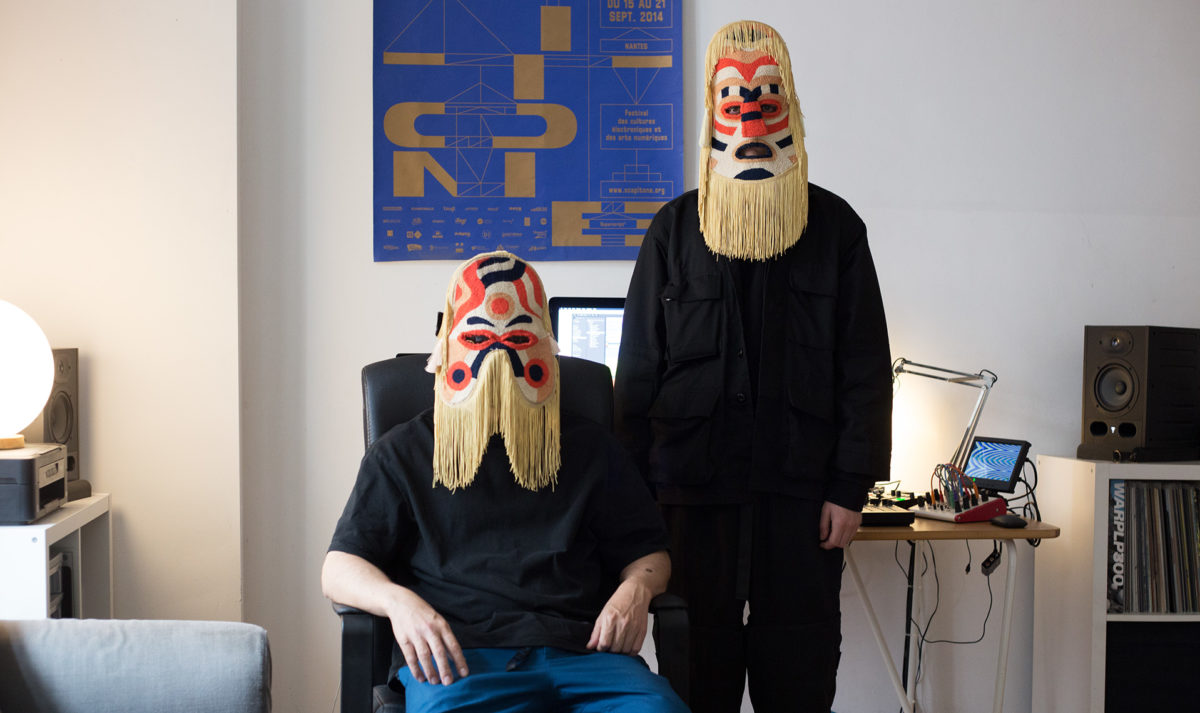
For now, it seems like “next” might be a return to their love of electronica. Dengue Dengue Dengue’s early projects explored a range of styles mostly rooted in drum & bass and dubstep. But their movement to marry “tropical futurism” with a folksier repertoire has given birth to a small but dedicated satellite scene that’s bringing digital textures to hints of music originally from the Amazonian region. Fiebre represents this novel paradigm: the productions are thick with the negative space and atmospherics the duo have been torch-bearing for decades. They also contain distinct allusions to the iconic Peruvian percussion the duo has re-appropriated – but deconstructed, in loopy layers, through their unique interweaving of the two.
You can listen to Fiebre in full right now over on Bandcamp. And don’t forget to check out our mini documentary that charts the band’s experiences recording in Peru with psychedelic cumbia legends Los Wembler’s de Iquitos.
Photos: Bahar Kaygusuz











